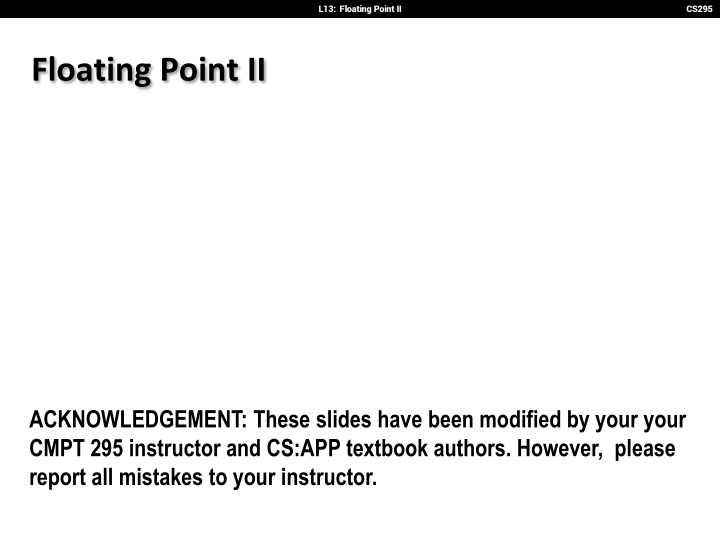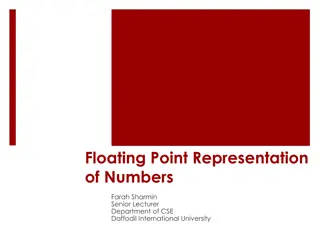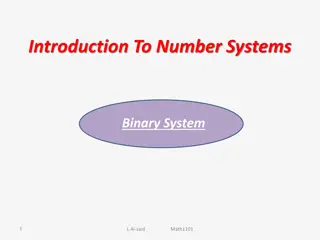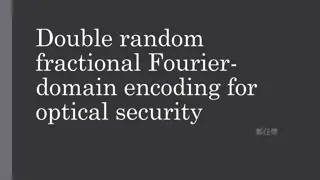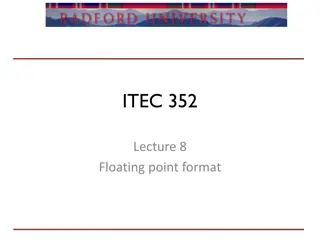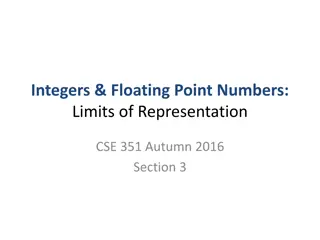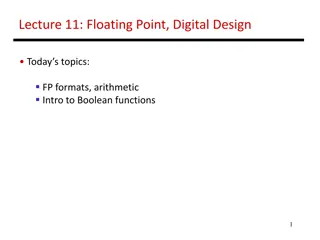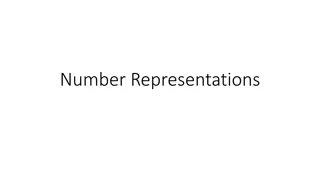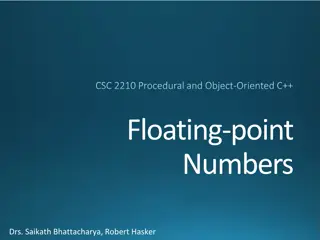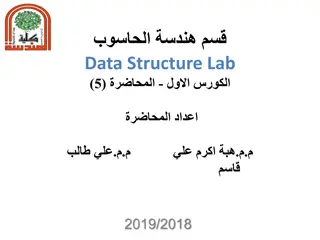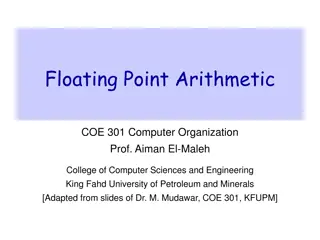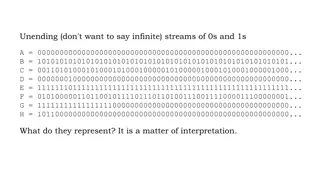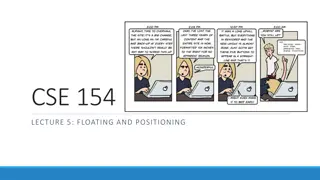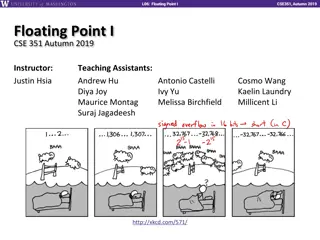Floating Point II: Fractional Binary Numbers and IEEE Standard
The intricate world of floating-point representation, this session delves into fractional binary numbers, the IEEE floating-point standard, and operations in C. With the aid of an 8-bit representation example, key concepts such as rounding and representable value ranges are illustrated. The discussion extends to understanding the nuances of encoding specific values and the distribution of values in floating-point representations.
Download Presentation

Please find below an Image/Link to download the presentation.
The content on the website is provided AS IS for your information and personal use only. It may not be sold, licensed, or shared on other websites without obtaining consent from the author.If you encounter any issues during the download, it is possible that the publisher has removed the file from their server.
You are allowed to download the files provided on this website for personal or commercial use, subject to the condition that they are used lawfully. All files are the property of their respective owners.
The content on the website is provided AS IS for your information and personal use only. It may not be sold, licensed, or shared on other websites without obtaining consent from the author.
E N D
Presentation Transcript
L13: Floating Point II CS295 Floating Point II ACKNOWLEDGEMENT: These slides have been modified by your your CMPT 295 instructor and CS:APP textbook authors. However, please report all mistakes to your instructor.
L13: Floating Point II CS295 Floating point topics Fractional binary numbers IEEE floating-point standard Floating-point operations and rounding Floating-point in C There are many more details that we won t cover It s a 58-page standard 2
L13: Floating Point II CS295 Tiny Floating Point Representation We will use the following 8-bit floating point representation to illustrate some key points: S 1 E 4 M 3 Assume that it has the same properties as IEEE floating point: bias = encoding of 0 = encoding of + = encoding of the largest (+) normalized # = encoding of the smallest (+) normalized # = 3
L13: Floating Point II CS295 Peer Instruction Question Using our 8-bit representation, what value gets stored when we try to encode 2.625 = 21 + 2-1 + 2-3? S E 1 4 M 3 A. + 2.5 B. + 2.625 C. + 2.75 D. + 3.25 E. We re lost 4
L13: Floating Point II CS295 Peer Instruction Question Using our 8-bit representation, what value gets stored when we try to encode 384 = 28 + 27? S 1 E 4 M 3 A. + 256 B. + 384 C. + D. NaN E. We re lost 5
L13: Floating Point II CS295 Distribution of Values What ranges are NOT representable? Between largest norm and infinity Between zero and smallest denorm Between norm numbers? Overflow (Exp too large) Underflow (Exp too small) Rounding Given a FP number, what s the bit pattern of the next largest representable number? What is this step when Exp = 0? What is this step when Exp = 100? Distribution of values is denser toward zero -15 -10 -5 0 Normalized 5 Infinity 10 15 Denormalized 6
L13: Floating Point II CS295 This is extra (non-testable) material Floating Point Rounding The IEEE 754 standard actually specifies different rounding modes: Round to nearest, ties to nearest even digit Round toward + (round up) Round toward (round down) Round toward 0 (truncation) S 1 E 4 M 3 In our tiny example: Man = 1.001 01 rounded to M = 0b001 Man = 1.001 11 rounded to M = 0b010 Man = 1.001 10 rounded to M = 0b010 7
L13: Floating Point II CS295 Floating Point Operations: Basic Idea Value = (-1)S Mantissa 2Exponent S E M x +f y = Round(x + y) x *f y = Round(x * y) Basic idea for floating point operations: First, compute the exact result Then round the result to make it fit into the specificed precision (width of M) Possibly over/underflow if exponent outside of range 8
L13: Floating Point II CS295 Mathematical Properties of FP Operations Overflow yields and underflow yields 0 Floats with value and NaN can be used in operations Result usually still or NaN, but not always intuitive Floating point operations do not work like real math, due to rounding Not associative: (3.14+1e100) 1e100 != 3.14+(1e100 1e100) 03.14 Not distributive: 100*(0.1+0.2) != 100*0.1+100*0.2 30.00000000000000355330 Not cumulative Repeatedly adding a very small number to a large one may do nothing 9
L13: Floating Point II CS295 Floating point topics Fractional binary numbers IEEE floating-point standard Floating-point operations and rounding Floating-point in C There are many more details that we won t cover It s a 58-page standard 10
L13: Floating Point II CS295 !!! Floating Point in C Two common levels of precision: float double 1.0f single precision (32-bit) 1.0 double precision (64-bit) #include <math.h> to get INFINITY and NAN constants Equality (==) comparisons between floating point numbers are tricky, and often return unexpected results, so just avoid them! 11
L13: Floating Point II CS295 !!! Floating Point Conversions in C Casting between int, float, and doublechanges the bit representation int float May be rounded (not enough bits in mantissa: 23) Overflow impossible int or float double Exact conversion (all 32-bit ints representable) long double Depends on word size (32-bit is exact, 64-bit may be rounded) double or float int Truncates fractional part (rounded toward zero) Not defined when out of range or NaN: generally sets to Tmin (even if the value is a very big positive) 12
L13: Floating Point II CS295 Peer Instruction Question We execute the following code in C. How many bytes are the same (value and position) between i and f? int i = 384; // 2^8 + 2^7 float f = (float) i; A. 0 bytes B. 1 byte C. 2 bytes D. 3 bytes E. We re lost 13
L13: Floating Point II CS295 Floating Point and the Programmer #include <stdio.h> $ ./a.out 0x3f800000 0x3f800001 f1 = 1.000000000 f2 = 1.000000119 int main(int argc, char* argv[]) { float f1 = 1.0; float f2 = 0.0; int i; for (i = 0; i < 10; i++) f2 += 1.0/10.0; f1 == f3? yes printf("0x%08x 0x%08x\n", *(int*)&f1, *(int*)&f2); printf("f1 = %10.9f\n", f1); printf("f2 = %10.9f\n\n", f2); f1 = 1E30; f2 = 1E-30; float f3 = f1 + f2; printf("f1 == f3? %s\n", f1 == f3 ? "yes" : "no" ); return 0; } 14
L13: Floating Point II CS295 Floating Point Summary Floats also suffer from the fixed number of bits available to represent them Can get overflow/underflow Gaps produced in representable numbers means we can lose precision, unlike ints Some simple fractions have no exact representation (e.g. 0.2) Every operation gets a slightly wrong result Floating point arithmetic not associative or distributive Mathematically equivalent ways of writing an expression may compute different results Never test floating point values for equality! Careful when converting between ints and floats! 15
L13: Floating Point II CS295 Number Representation Really Matters 1991: Patriot missile targeting error clock skew due to conversion from integer to floating point 1996: Ariane 5 rocket exploded ($1 billion) overflow converting 64-bit floating point to 16-bit integer 2000: Y2K problem limited (decimal) representation: overflow, wrap-around 2038: Unix epoch rollover Unix epoch = seconds since 12am, January 1, 1970 signed 32-bit integer representation rolls over to TMin in 2038 Other related bugs: 1982: Vancouver Stock Exchange 10% error in less than 2 years 1994: Intel Pentium FDIV (floating point division) HW bug ($475 million) 1997: USS Yorktown smart warship stranded: divide by zero 1998: Mars Climate Orbiter crashed: unit mismatch ($193 million) 16
